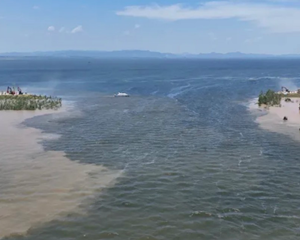Local authorities said a 226-meter breach in a dike at China's second-largest freshwater was sealed.
当地政府日前表示,中国第二大淡水湖河堤上一道226米的决口已被封堵。
They said advanced technology is one of the main reasons behind the speedy repairs.
他们表示,先进的技术是快速修复背后的主要原因之一。
"Artificial Intelligence helped us to quickly get the data of the velocity of the flow when the dike breach occurred.
“人工智能帮助我们快速获得了溃坝时的流速数据。
With our independently-developed model, we could also analyze the process of flood routing as fast as possible.
利用我们自主研发的模型,我们还可以尽快地分析出洪水的演进过程。
Based on the basic information of the dike, we've divided zones with possible risks.
根据堤防的基本情况,我们划分了可能存在风险的区域。

For those at high risk, we've analyzed their stability so as to offer data support to provide further alerts about any bursts."
对于那些高风险的区域,我们已经分析了它们的稳定性,以便提供数据支持,来提供有关任何决堤的进一步警报。”
Apart from technology used on the ground, support from the sky is also significant.
除了地面上使用的技术,来自空中的支持也很重要。
"Facing strong wind and other formidable natural conditions, we use optical satellite and radar to monitor situations on set. Especially at night, radar can cross over clouds and mist.
“面对强风和其他可怕的自然条件,我们使用光学卫星和雷达来监测拍摄现场的情况。特别是在夜间,雷达可以越过云雾。
We also use the monitor platform with remote sensing technology to process data so as to monitor the flooding range and the width of the breach."
我们还利用监测平台和遥感技术处理数据,以监测洪水的范围和决口的宽度。”
Song said the remote sensing technology can also help to recognize which parts are safe, without being submerged by water.
宋文龙表示,遥感技术还可以帮助识别哪些部分是安全的,而不会被水淹没。


